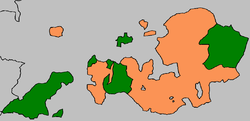
Back أنهالت برنبورغ Arabic Анхалт-Бернбург Bulgarian Anhalt-Bernburg Catalan Anhaltsko-bernburské knížectví Czech Anhalt-Bernburg Danish Fürstentum Anhalt-Bernburg German Anhalt-Bernburg Spanish Anhalt-Bernburg Estonian Duché d'Anhalt-Bernbourg French Diùcachd Anhalt-Bernburg Scots/Gaelic
This article needs additional citations for verification. (October 2017) |
Principality (Duchy) of Anhalt-Bernburg Fürstentum (Herzogtum) Anhalt-Bernburg (German) | |||||||||
|---|---|---|---|---|---|---|---|---|---|
| 1252–1468 1603–1863 | |||||||||
 The Anhalt territories in 1853, with Anhalt-Bernburg in green | |||||||||
| Status | State of the Holy Roman Empire (until 1806) State of the Confederation of the Rhine (1806–13) State of the German Confederation (from 1815) | ||||||||
| Capital | Bernburg | ||||||||
| Common languages | Upper Saxon | ||||||||
| Government | Principality | ||||||||
| Prince | |||||||||
• 1252–1287 | Bernhard I (first) | ||||||||
• 1796–1803 | Alexius Frederick Christian (last) | ||||||||
| Historical era | Middle Ages | ||||||||
• Partitioned from Anhalt | 1252 | ||||||||
• Inherited by Anhalt-Dessau | 1468 | ||||||||
• Repartitioned from Anhalt | 1603 | ||||||||
• Anhalt-Zeitz-Hoym partitioned away | 1718–1812 | ||||||||
• Raised to duchy | 1803 | ||||||||
• Anhalt re-united | 1863 | ||||||||
| |||||||||
| Today part of | Saxony-Anhalt, Germany | ||||||||
Anhalt-Bernburg was a principality of the Holy Roman Empire and a duchy of the German Confederation ruled by the House of Ascania with its residence at Bernburg in present-day Saxony-Anhalt. It emerged as a subdivision from the Principality of Anhalt from 1252 until 1468, when it fell to the Ascanian principality of Anhalt-Dessau. Recreated in 1603, Anhalt-Bernburg finally merged into the re-unified Duchy of Anhalt upon the extinction of the line in 1863.

